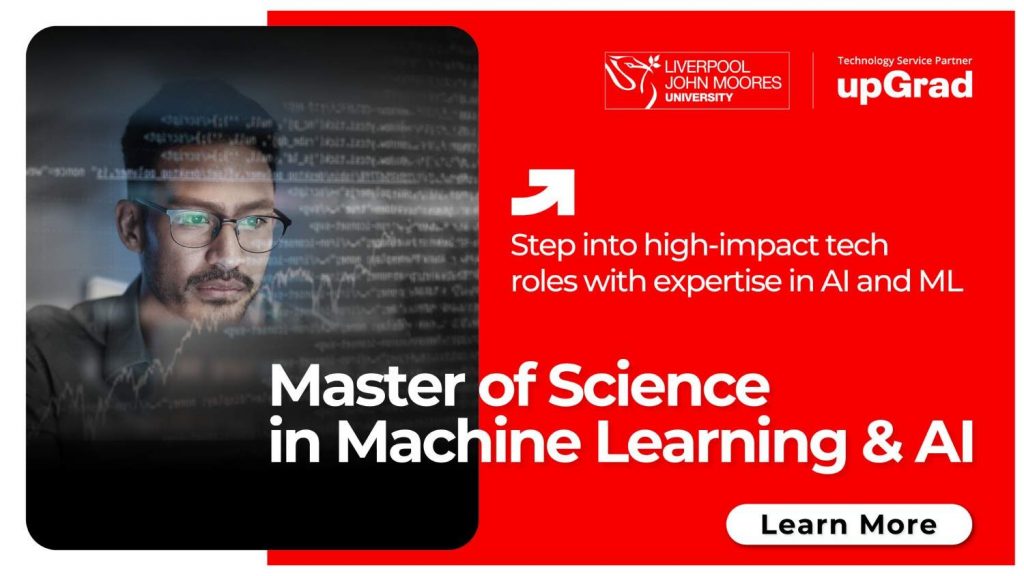Supervised learning is a type of machine learning algorithm that uses labeled data to make predictions about unseen or future data. It has become increasingly popular for businesses, researchers, and machine learning engineers over the past few years as it enables machines to learn from past experiences and apply those learnings in new situations. It involves providing the machine with an input dataset containing labels representing different classes or categories and then identifying patterns within this dataset.
In essence, it creates a learning environment similar to a classroom where a student learns under the supervision of a teacher or instructor. By doing so, supervised learning can be used to create accurate models, generate insights, and make predictions on previously untested datasets.
This article will provide an overview of supervised learning and explain its types, techniques, and applications in 2026.
Take your skills to the next level — Explore AI & ML Certification Online for USA Professionals
What Is Supervised Learning?
Supervised Learning is a machine training method that uses labeled data, including input and output parameters. The labeled data is already tagged with the correct answer. Afterward, the machine is tested with new data sets, and it is expected to generate the correct outcome based on its analysis of the labeled data.
It is a form of “learning with a teacher,” as the machine is instructed on what to do with the data it is given. Supervised learning algorithms can be used for both classification and regression problems. In classification, the algorithm looks at a set of labeled data points and attempts to assign each point to one of several predefined labels or classes. In regression, the algorithm attempts to predict an output based on its understanding of relationships.
Encouraging a culture of continuous learning among employees and leaders prepares them to handle future disruptions caused by the unpredictable business environment. The automation revolution has also facilitated a learning environment and increased the workforce’s interest in upskilling with artificial intelligence, machine learning, and deep learning technologies. Supervised learning has emerged as one of the most widely used machine learning techniques for predictive analytics and data intelligence.
When do we use Supervised Learning?
Supervised learning can be used in many scenarios and applications. It is most commonly used for predictive analytics, image or speech recognition, natural language processing (NLP), anomaly detection, and robotics.
It has seen increasing popularity among businesses for use cases like customer segmentation, marketing campaign evaluation, fraud prevention, inventory optimization, and predictive maintenance. By providing machines with labeled data sets from past experiments or experiences, supervised learning enables them to learn from previous insights and generate predictions with greater accuracy than ever before.
For example, a supervised machine learning algorithm can be used to identify fraudulent transactions by analyzing past transaction data. The system identifies patterns that match the characteristics of previously identified fraud cases and flags them as potential risks.
What Are The Types Of Supervised Learning?
Different algorithms and computation methods are utilized in the process of supervised learning. Listed below are some examples of commonly used supervised learning algorithms.
Regression
Regression is a type of supervised learning that helps to predict continuous output based on labeled data sets. It aims to understand the connection between independent and dependable variables. It is generally used in situations where the output should be a specific value, such as weight or height. There are two types of regression:
1. Linear Regression
This type of regression uses a linear relationship between the variables and attempts to minimize the error by finding the line of best fit. For example, it can be used to predict the stock market performance of a particular company.
2. Logistic Regression
Logistic regression is another supervised learning algorithm that predicts discrete output based on labeled data sets. It uses a logistic function to map the input values into binary outputs. For example, it can be used for email spam detection where the output will have two labels – ‘spam’ and ‘not spam.
Also read: Key Details to Know about Neural Networks and Deep Learning
Classification
Classification is supervised learning that helps assign input data points into predefined categories or labels. It involves classifying the data points into two or more classes using Boolean algebra. Common examples include sentiment analysis, facial recognition, and handwriting recognition. Here are some examples of classification algorithms:
Decision Tree
This algorithm splits the data points into smaller subsets and creates a tree-like structure. It uses a decision point at each node which is used to split the dataset according to certain conditions.
KNN (K Nearest Neighbors)
KNN is one of the most commonly used algorithms for classification problems, especially in the field of computer vision. It ‘neighboring’ data points, i.e., those similar to a given input value, and assigns them to the same label or class accordingly.
SVM (Support Vector Machine)
SVM is another popular algorithm for classification problems. It works by finding an optimal hyperplane that divides the data into two parts based on their labels. By finding the optimal hyperplane, it can classify new data points with high accuracy.
Also read: From Novice to Neural Network: A Beginner’s Guide to Learn AI and ML
Linear Classifiers
Linear classifiers are simple algorithms that classify data points by drawing a straight line in the feature space. It works well with datasets that have few features and can generate highly accurate models.
Random Forest
Random forest is an ensemble algorithm that combines multiple decision trees to classify data points. It works by randomly selecting a set of decision trees and averaging their predictions. This helps in reducing the variance of the model and improving its accuracy.
Naive Bayes
The Naive Bayes algorithm is best suited for large datasets because each program in the algorithm operates independently. This ensures that the presence of one feature does not affect the others. The algorithm is commonly used in applications like text classification and recommendation systems.
Different types of Naive Bayes models can be used for classification, such as Gaussian Naive Bayes and Multinomial Naive Bayes.
- Gaussian Naive Bayes uses the Gaussian distribution to model data points and calculates probabilities. It works with continuous data types such as age, height, etc.
- Multinomial Naive Bayes models discrete features such as word counts in text documents.
Neural Networks
Neural networks, also known as the ‘black-box’ algorithm, are a set of mathematical models used to simulate the behavior of biological neurons. They can be used for both supervised and unsupervised learning tasks. In recent years, neural networks have become increasingly popular in areas such as image recognition, speech recognition, natural language processing, etc.
There are many types of neural networks, like convolutional neural networks (CNNs), recurrent neural networks (RNNs), deep belief networks (DBNs), and more. Each type is suitable for different kinds of problems and applications. For example, CNNs are often used for image classification tasks, while RNNs are designed to work with time-sensitive data such as audio or video streams.
Also read: Understanding Recurrent Neural Networks: Applications and Examples
What Are The Techniques of Supervised Learning?
Supervised learning techniques mainly depend on the type of data used and the problem that needs to be solved. Common techniques include:
1. Regression analysis:
This technique is used to identify relationships between input variables and a continuous output variable. It can help predict the value of an output variable given one or more input variables.
2. Classification algorithms:
These are used to assign class labels to inputs based on training data. Some examples include decision trees, support vector machines (SVMs), and k-nearest neighbors (k-NN).
3. Clustering:
This technique helps group similar data points into clusters according to certain characteristics to discover hidden patterns in the data. Examples include hierarchical clustering, k-means clustering, and Gaussian mixture models.
4. Ensemble learning:
This technique combines multiple predictive models to improve the overall prediction accuracy and reduce the amount of variance in the model. Examples include random forests, bagging, boosting, and stacking.
By understanding these techniques and selecting the right one for your problem, you can build effective supervised learning models that help you make accurate predictions or classifications on your data.
Also read: Real-World Applications of Machine Learning in Finance Industry
Benefits and Limitations of Supervised Learning
Supervised learning offers many benefits to data scientists and machine learning engineers. It allows them to create models that can easily be tested, debugged, and improved upon. Additionally, supervised learning algorithms can be used to detect patterns in the data more accurately than humans.
However, there are some limitations of supervised learning as well. The most significant limitation is its reliance on labeled data. Labeling a large dataset can be time-consuming and expensive. Additionally, since these models rely heavily on the quality of input features, they may not always yield accurate results if the features are noisy or incomplete. Finally, supervised learning algorithms require a lot of computing power and memory for training and prediction tasks, so they can become prohibitively expensive when working with large datasets.
Supervised vs. Unsupervised Learning
Supervised and unsupervised learning differ in terms of how the algorithm is trained. In supervised learning, a labeled training set is provided to the algorithm with correct output values. On the other hand, unsupervised learning algorithms are provided with unlabeled data, where the algorithm determines patterns and similarities within the dataset without any external measurement or correct output values.
To put it simply, algorithms can operate independently to gain a deeper understanding of data and discover intriguing or unforeseen patterns that humans may have overlooked. Unsupervised learning is commonly utilized when data clustering (identifying groups within data) and association (predicting rules that describe the data) are necessary.
Conclusion
Supervised learning has become a popular field in machine learning due to its ability to provide accurate predictions and classifications. However, it is important to select the right type of supervised learning algorithm for your specific problem, as there are certain limitations associated with this technique.
Additionally, it’s important to understand the difference between supervised and unsupervised learning in order to make informed decisions about which technique to use for a given problem. By understanding these concepts, you can make better decisions about how best to use supervised learning for predictive analytics in data science projects and applications.
Relevant Programs via upGrad:
- Master of Science in Machine Learning & AI (Liverpool John Moores University)
- Executive Diploma in Machine Learning & AI (IIT Bangalore)
Must read articles:
- The Future of AI and ML: Predictions and Trends to Watch
- Understanding Recurrent Neural Networks: Applications and Examples
- Key Details to Know about Neural Networks and Deep Learning
- Top AI and ML Certifications to Boost Your Career in the US
🎓 Explore Our Top-Rated Courses in United States
Take the next step in your career with industry-relevant online courses designed for working professionals in the United States.
- DBA Courses in United States
- Data Science Courses in United States
- MBA Courses in United States
- AI ML Courses in United States
- Digital Marketing Courses in United States
- Product Management Courses in United States
- Generative AI Courses in United States
FAQs on Supervised Learning
Supervised learning means training a model using labeled data so it can make accurate predictions or classifications.
Supervised learning meaning refers to teaching an algorithm with example input–output pairs so it learns how to map new data correctly.
The common types of supervised learning include classification, regression, and sequence labeling.
Popular supervised learning techniques include linear regression, logistic regression, decision trees, random forests, support vector machines, and neural networks.
Analytics itself is not classified as supervised learning, but certain analytical methods use supervised learning models when labeled datasets are involved.








